The everyday life of medieval people was often far from the ideal of ora et labora. Their heads were filled with hairy thoughts, and forbidden temptations swarmed around them. What were these temptations, and how were they succumbed to them? You have to see it!
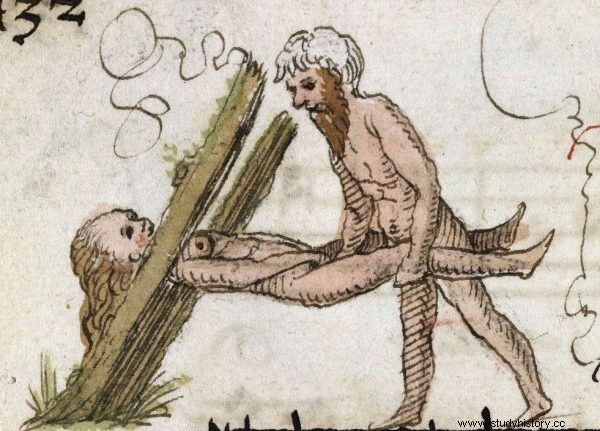
Medieval forbidden fruit - having sex in a non-canonical position. Initial "A" in the Bruges songbook (source:public domain).
The model of marriage in the middle ages came from the Bible's teaching that a wife was to be obedient and submissive to her husband. Marriage duties should be fulfilled without taking pleasure in them which the Church condemned as harmful to the salvation of the soul and disrupting the social order.
Any sex outside of marriage was sinful, and even in marriage it was to be practiced solely for the purpose of procreation, avoiding unnatural pleasures.
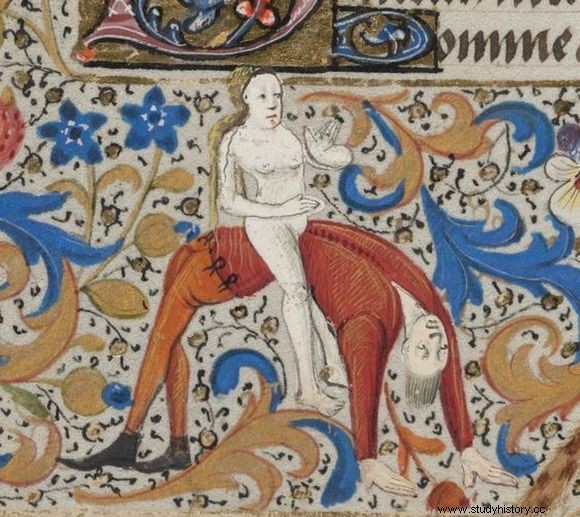
Could such forbidden games be dreamed of by medieval spouses at night? French hours from the 15th century (source:public domain).
Marital sex was also supposed to keep cravings in check, which is why it was governed by many rules. And although the missionary position was the most desirable and pleasing to God, for example, Albert the Great, a 13th-century Dominican and doctor of the Church, allowed some exceptions.
He considered some positions less sinful than others. The smallest deviation is the position on the side, then sitting, standing and finally - the largest - from the back, like horses .
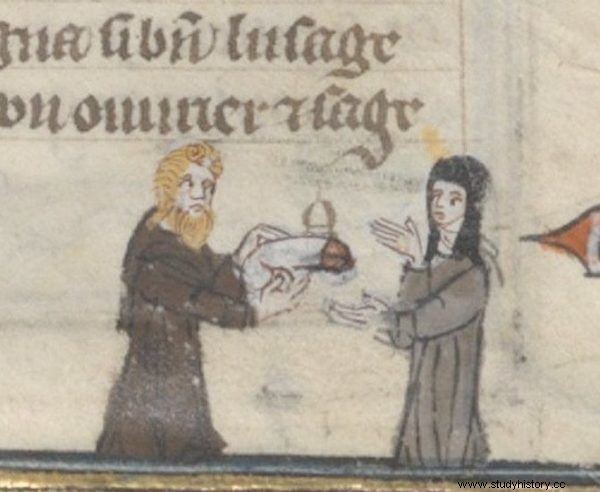
Flirting in the church? Illustration from "Roman de la Rose" from the 14th century (source:public domain).
According to one of the medieval classifications of the sin of impurity, simple adultery was of the least importance, followed by depriving a virgin, adultery, rape, sacrilegious sex with a nun , then incest, and the worst was "offense against nature." Where was innocent flirting in this hierarchy?
St. The Bernardine of Siena claimed that there was nothing innocent about flirting. He thundered that some women were brazen and shameless enough to flirt even in church, and that the girls' mothers became their pimps, placing them in such a place that the suitors can watch, following their every move . It's scary to think what those "pimping mothers" encouraged their daughters to do during balls or festivals ...
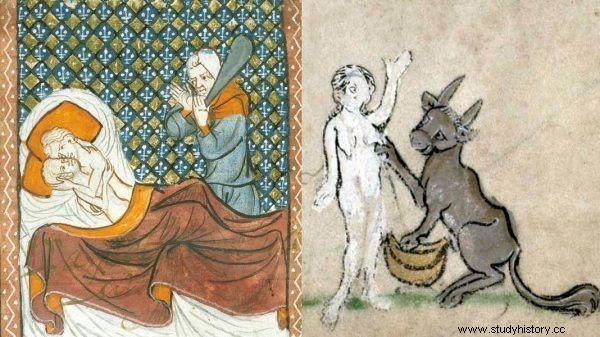
No matter how you look at it, sin was shaped like a woman and came from her ... On the left Mars and Venus found in the bed by Vulcan, "Roman de la Rose", France around 1380, on the right Flanders hours from around 1300 (source :public domain).
In the Middle Ages, the blame for the sin of impurity was blamed on a woman, prone to debauchery and greed, drawing a man into sin. Saint Peter Damiani, one of the Fathers of the Church, believed that God knows only three types of women:virgins, wives and widows.
All the others that do not fit into any of these categories stand no chance of facing the divine face. Female inclinations bring them closer to Satan, and licentiousness tempt men whom they bind them in a sticky web of love and they lead astray into the path of iniquity.
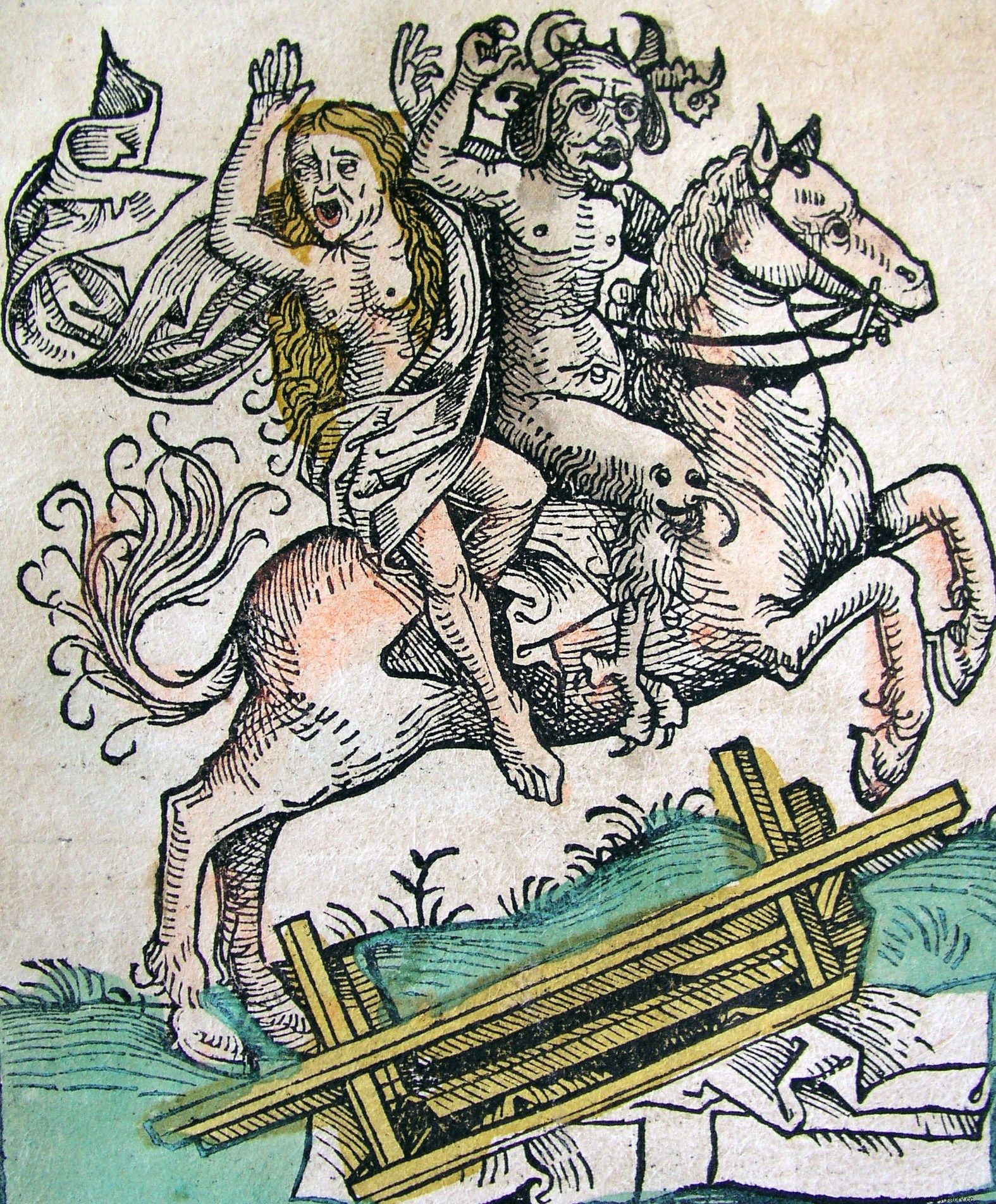
Sinful by nature, the woman was a dream lover for devils and demons. The Nuremberg Chronicle from 1493 (source:public domain).
The Church in the Middle Ages took a clear position towards women:Eve allowed herself to be tempted by the devil and dragged Adam with her, which led to the fall of mankind. The woman was not only biologically but morally inferior, representing a propensity to sin and therefore susceptibility to satanic temptations.
Sinful by nature, she became the perfect concubine for the demons with whom she willingly and willingly indulged in debauchery. In one of the many miracles he had performed, Bernard of Clairvaux freed the wife of a knight from his infernal lover. St. Brigid of Sweden also helped the woman who was persecuted by the demon.

No one was surprised when the clergy plunged into debauchery. On the left, an illustration from the Decameron from the 30s of the 15th century, Count Charles de Croy-Chimay, on the right, an illumination of a manuscript from 1440 (source:public domain).
In the Middle Ages, the clergy was far from being pure chastity:Church servants often had concubines, and regular clients of prostitutes were priests and religious. Of course, when men were committing the sin of fornication, it was to be assumed that they were led to it by the women.
And although, for example, Gloucester had a law that punished a cleric if a cleric practiced acts unworthy of prostitutes or married women nobody cared about it. London transvestite John "Eleanor" Rykener, arrested for prostitution and wearing women's clothes in 1395 , confessed to regularly providing services to priests, men and women religious who gave him expensive gifts.
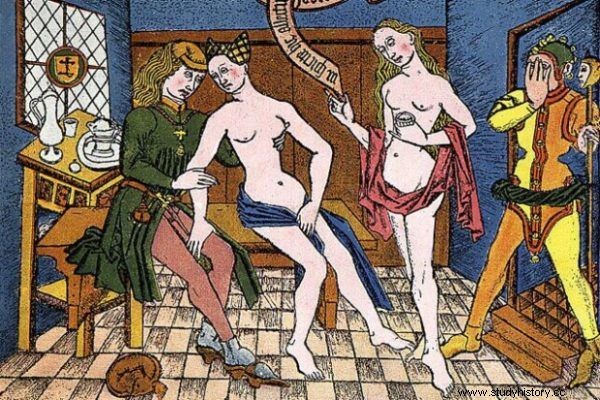
Lupanar like a home toilet? Well, when you want to justify something, you will find a way ... 15th century house of debauchery (source:public domain).
Prostitutes did not have an easy life in the Middle Ages, despite the fact that their presence was socially desirable. St. Thomas Aquinas claimed that lupanars are like a household toilet - they smell bad, but without them the whole house would stink. For example, during the council of Constance countless prostitutes arrived in the city and the chronicler Ulrich von Richental named seven hundred openly engaged in harlotry.
The law did not protect the harlots, they had to differ in their clothes from "honest" women, and sometimes they were harassed and expelled from the city, as in 1310 from London. The authorities of Oxford and Cambridge followed the example of the capital, concerned about the decline of morals among… students.
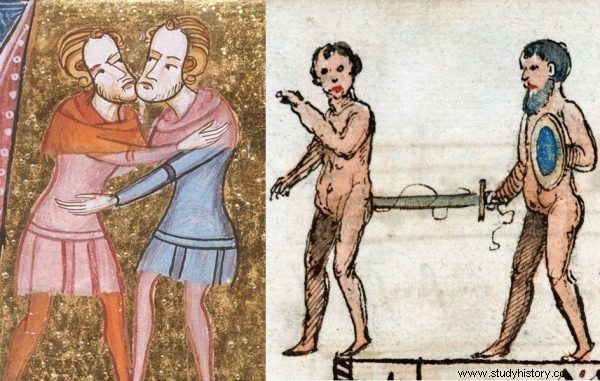
Is it just male friendship? (source:public domain).
In the Middle Ages, the terms "homosexuality," "gay," or "lesbian," were not known, and same-sex acts of eroticism were referred to as sodomy.
These acts were considered to be the sin of licentiousness of the worst kind, because it was contrary to nature ( peccatum contra naturam ) that could have been committed ratione generis , that is, with an animal, ratione sexus that is, with a person of the same sex or ratione mondi and therefore with a person of the opposite sex.
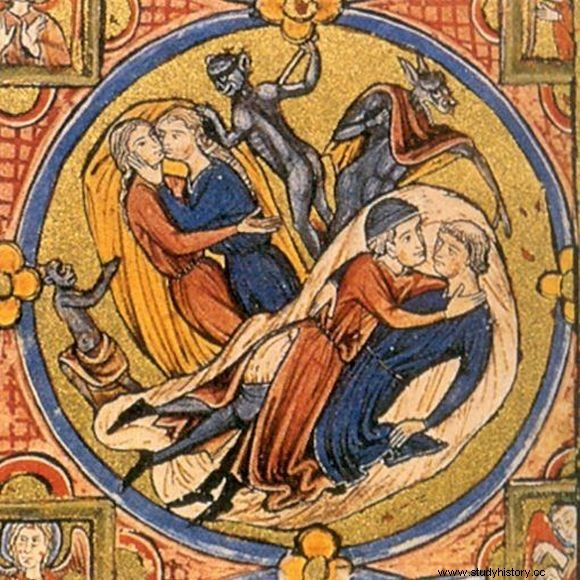
Are these ladies not going to go too far? Moralistic illustration from the early 13th century Vindbonesis (source:public domain).
St. Antoninus in his textbook for confessors wrote: A man with a man, a woman with a woman, a man with a woman leaving semen not in the reservoir that nature assigned for it - these are the sins of sodomy. Such practices were subject to condemnation, sinners were often tortured and ended up at the stake.
Meanwhile, in Florence, homosexuality was said to be so frequent that florenzer in the German countries it meant just a sodomite. Even the rulers did not protect themselves from the accusations. The Sodomites were reportedly William the Conqueror, Richard the Lionheart, Edward II and Henry IV Lancaster.
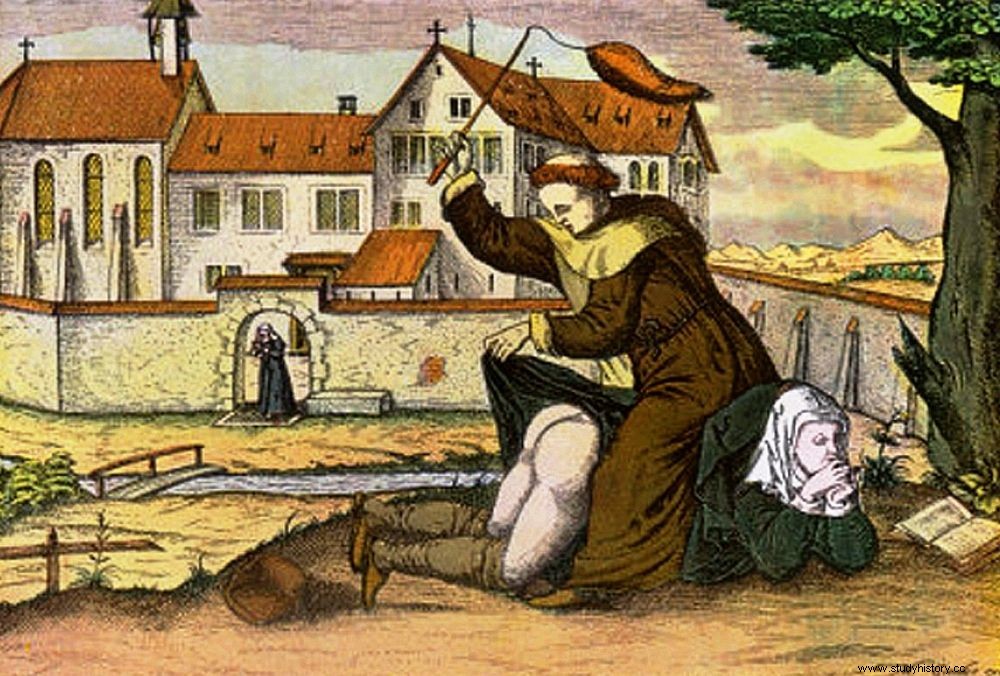
Sado-maso in a habit? Why not, after all, in an era full of violence, many found satisfaction in inflicting pain (photo:vpagnouf, flickr, license CC BY SA 2.0).
The Middle Ages were times when offenses were punished severely, often cruelly. Already in school, for the slightest offense, the student was beaten with a birch rod, leather discipline or a leather placenta mounted on a wooden shaft. People were used to the suffering and death they saw every day, and many of them enjoyed watching public forms of punishment.
Public flogging, which was one of the favorite punishments of the Middle Ages, was subjected to, for example, thieves or prostitutes at the pillory, which always attracted those willing, eager to fill their eyes with the sight of torture and ears with the screams of the suffering.
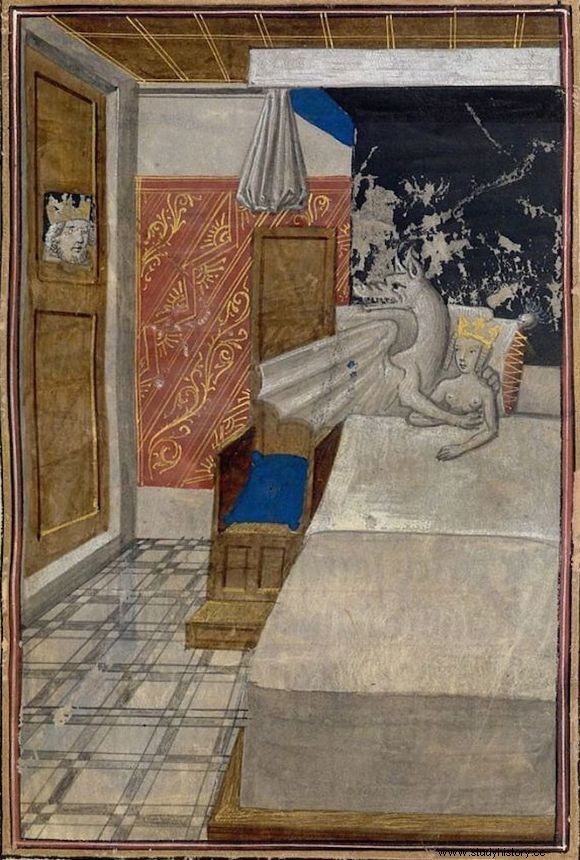
What are you staring at? I prefer the dragon in bed to you! Brugge's Historiae Aleksandri Magni from around 1468-1475 (source:public domain).
St. Thomas distinguished the following "sins against nature":masturbation or effeminacy, zoophilia or intercourse with animals, sodomy or intercourse with persons of the same sex, and finally those sexual acts in which the natural way of mating is not respected.
Perhaps the latter category included oral sex, intermittent intercourse and sinful positions.
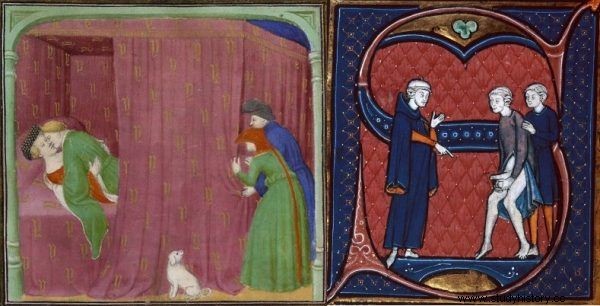
I'll see here, show you there… and she'll be excited. On the left, an illustration from the French manuscript "De proprietatibus rerum" from 1410, on the right, the 13th-century "Canon medicinae" by Avicenna (source:public domain).
Zoophilia was, according to St. Tomasz was an exceptionally serious sin and faced severe punishments. At best, man received a penance, which could last even to the end of his life, and God of the spirit was slaughtered by the animal that was guilty. St. Columban recommended that lay people should be punished with one-year fast after marriage, and single people should be punished with six-month fast, but often such people should be stoned to death.
Minor offenses, such as exposing in public or watching love games in someone else's alcove, were easier to escape. Even swinging was popular , as evidenced by court documents and laws preserved to this day prohibiting such practices from the 13th-century Venice and Genoa.
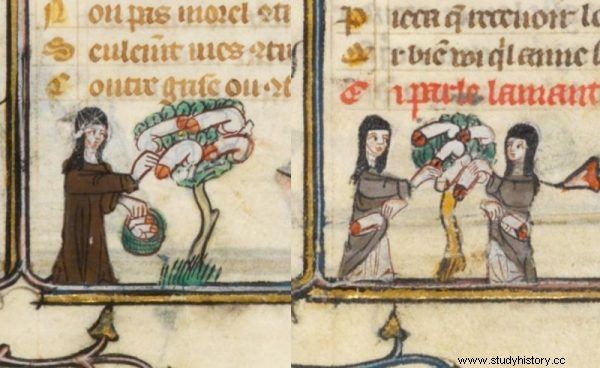
The best way to deal with boredom is dirty pictures? A 14th-century copy of "Roman de la Rose" (source:public domain).
Monks copying medieval manuscripts sometimes fell into routine, not to say boredom. Their work took a blush when decorated the margins with fancy illustrations.
Their imaginations were certainly fueled by vivid descriptions in medieval religious books, such as scenes in illustrated codices for German Dominican women, where Christ whips a naked Soul and then lays it down in bed so that they can consume the relationship.
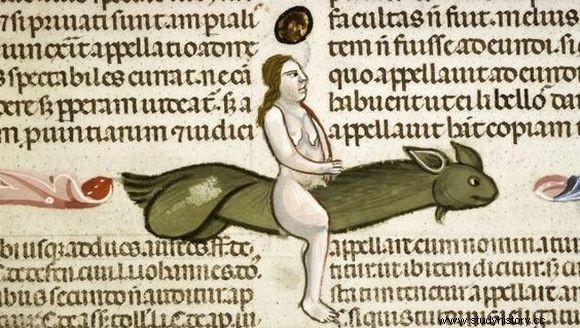
How many people has a picture like this inspired to commit sinful activities? "Decretum Gratiani" with commentary by Bartolomeo de Brescia, Italy, 1340-1345 (source:public domain).
Many monks could boast of a rich erotic experience, others simply implemented their fantasies and unfulfilled dreams.
Today we can only guess at the intentions of medieval portholes, but they certainly cannot be denied the craftsmanship and imagination, which perhaps led many owners or owners of such a decorated psalter to sin.
